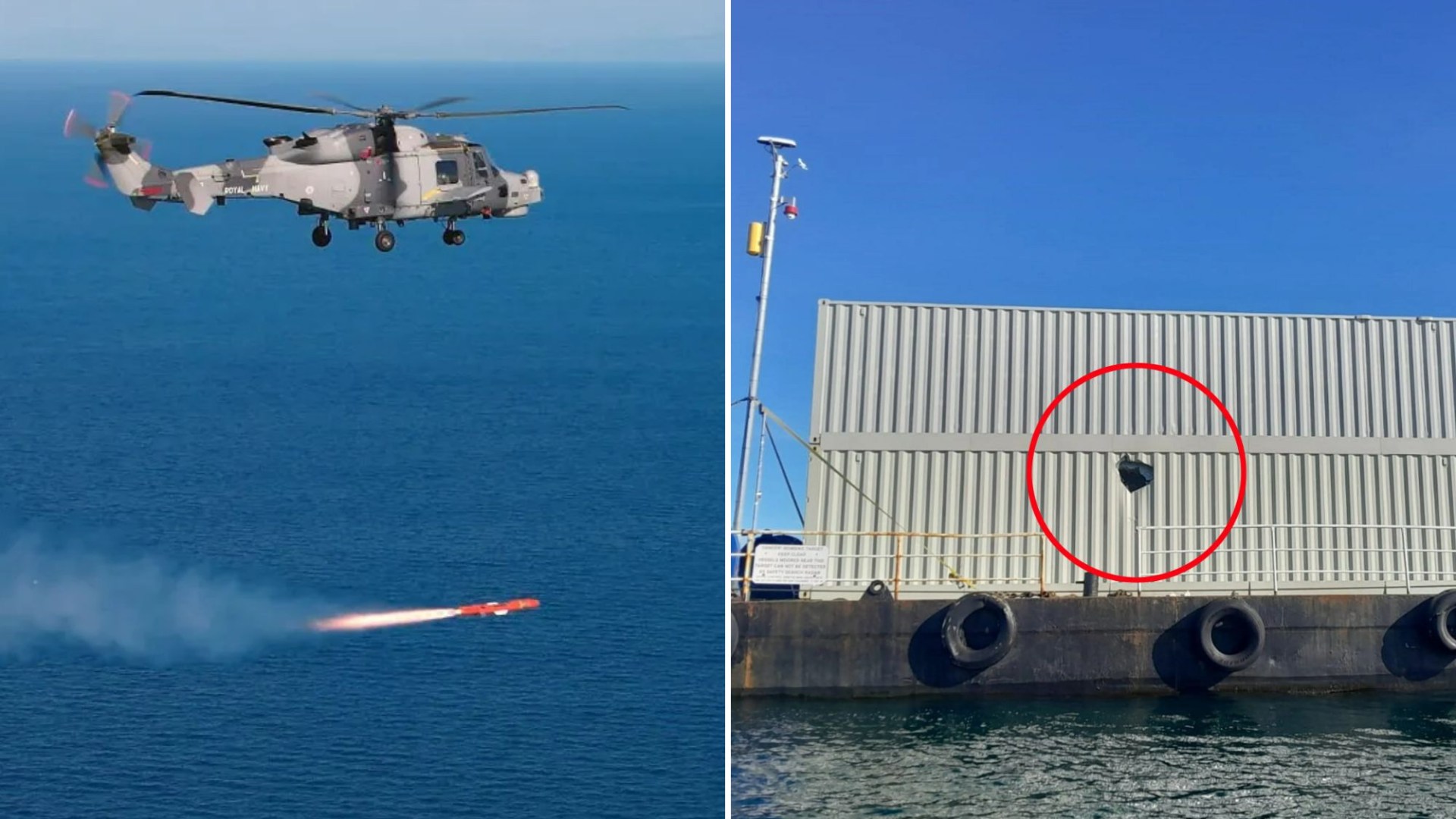INCREDIBLE footage has captured the moment the Royal Navy tested out their new £1billion Sea Venom missiles which can destroy ships miles away.
The Wildcat HMA Mk2 already packs a punch, able to fire Sting Ray torpedoes at underwater threats and lightweight Martlet missiles at smaller targets.
2

2
But until now, the maritime helicopters have not had a way to target larger ships like corvettes.
That has now changed with the first guided firing of the Sea Venom missile at a practice target at the MOD Aberporth range in Wales.
It means that attack choppers will soon pack an even bigger punch and be able to destroy more heavily armoured ships.
This missile is a significant upgrade, offering 10 times the firepower of the Martlet and specifically designed to tackle more heavily armoured vessels.
Lieutenant Commander Robin Kenchington, from the Royal Navy’s test and evaluation squadron 744 Naval Air Squadron, said: “It was fantastic to see a full end-to-end demonstration of the missile.
“Every aspect of the firing worked well – from the ease-of-use in-cockpit for crews, through the performance of the missile in flight, right up to the accuracy on the target.
“The Wildcat has another potent addition to its arsenal, increasing the ability of front-line crews to fight from a greater stand-off distance; this maximises their lethality whilst keeping them safe from enemy defences.”
The target vessel was designed and built by QinetiQ engineers, made of three containers atop a barge.
Each container wall had multiple individually controlled heating elements to simulate a target more accurately.
The firing marks a significant milestone in the integration of Sea Venom onto Wildcat.
It will add to the potent array of weaponry protecting Royal Navy warships, namely the Queen Elizabeth-class aircraft carriers.
Pete Fawcett, the Senior Responsible Owner of the Future Air-to-Surface Guided Weapon, said: “This first guided firing is a significant step forward for the integration of Sea Venom onto the Royal Navy’s Wildcat helicopters.
“The success of the trial was the result of an outstanding team effort across Leonardo UK, MBDA, QinetiQ and the Ministry of Defence.”
The Yeovilton-based Wildcat Maritime Force, some 400 people and 28 Wildcats under its two squadrons, are those pushing the maritime variant of the helicopter – the HMA Mk2 – into the future.
The 815 Naval Air Squadron takes care of front-line operational work on Royal Navy ships around the world.
Meanwhile, its sister 825 Naval Air Squadron’s business is training and developing the aircraft, identifying, and understanding its potential.
The Wildcats, which came into service in 2015, have been given notable firepower in recent years, with the addition of a new weapons-carriage to carry torpedoes and missiles.
The helicopters can also wield a.50 calibre machine gun on its door and play host to Royal Marines sniper teams capable of knocking out a drug smuggling speed boat from range.
The programme has been a collaborative effort by MOD and industry teams around the UK and consisted of a single firing.
Commodore Nick Sargent, DE&S’ Head of Helicopters, added: “These firings mark a vital step forward in the integration of the Sea Venom missile into what is already an outstanding helicopter to provide the Royal Navy with a world-class capability.
“I am grateful to all those across industry and the Ministry of Defence who have worked so hard to achieve this milestone.”
What are Sea Venom missiles?
Sea Venom is the latest weapon to be developed, replacing the Sea Skua which went out of service in 2017.
This modern anti-ship missile can engage targets from safe distances of up to 20km and has a 30kg warhead.
It offers a variety of different flight profiles – including sea skimming – and can be fired in a salvo.
It’s a big leap in technology for the Wildcat, featuring a two-way data link that allows the operator to control the missile during flight.
This means they can re-target, correct the final aim, or safely abort the mission if needed.
It comes after Britain’s new nuclear attack submarine with a Rolls-Royce reactor and six torpedoes launched for the first time.
HMS Agamemnon, the latest Royal Navy Astute Class attack sub, set off at BAE Systems in Barrow-in-Furness, Cumbria.
Named after the ancient Greek king who launched the Trojan War, it is the sixth of seven, all of which have been designed and built at the Company’s historic Barrow shipyard – home of UK submarine building.
The nuclear-powered boat, which weighs in at 7,400 tonnes and is 97 metres long, rolled out of the Devonshire Dock Hall and entered the water this morning.
Agamemnon will now begin the next phase of its test and commissioning programme, before leaving Barrow for sea trials with the Royal Navy.




